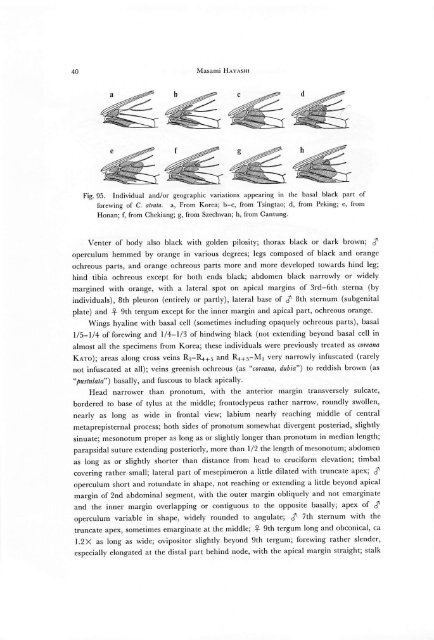A Revision of the Genus Cryptotympana (Homoptera, Cicadidae)
A Revision of the Genus Cryptotympana (Homoptera, Cicadidae)
A Revision of the Genus Cryptotympana (Homoptera, Cicadidae)
Create successful ePaper yourself
Turn your PDF publications into a flip-book with our unique Google optimized e-Paper software.
40 Masami HayashiFig. 95. Individual and/or geographic variations appearing in <strong>the</strong> basal black part <strong>of</strong>forewing <strong>of</strong> C. atrata. a, From Korea; b-c, from Tsingtao; d, from Peking; e, fromHonan; f, from Chekiang; g, from Szechwan; h, from Cantung.Venter <strong>of</strong> body also black with golden pilosity; thorax black or dark brown; foperculum hemmed by orange in various degrees; legs composed <strong>of</strong> black and orangeochreous parts, and orange ochreous parts more and more developed towards hind leg;hind tibia ochreous except for both ends black; abdomen black narrowly or widelymargined with orange, with a lateral spot on apical margins <strong>of</strong> 3rd-6th sterna (byindividuals), 8th pleuron (entirely or partly), lateral base <strong>of</strong> f 8th sternum (subgenitalplate) and -£ 9th tergum except for <strong>the</strong> inner margin and apical part, ochreous orange.Wings hyaline with basal cell (sometimes including opaquely ochreous parts), basal1/5-1/4 <strong>of</strong> forewing and 1/4-1/3 <strong>of</strong> hindwing black (not extending beyond basal cell inalmost all <strong>the</strong> specimens from Korea; <strong>the</strong>se individuals were previously treated as coreanaKato); areas along cross veins R3-R4+5 and R^-M! very narrowly infuscated (rarelynot infuscated at all); veins greenish ochreous (as "coreana, dubia") to reddish brown (as"pustulata") basally, and fuscous to black apically.Head narrower than pronotum, with <strong>the</strong> anterior margin transversely sulcate,bordered to base <strong>of</strong> tylus at <strong>the</strong> middle; frontoclypcus ra<strong>the</strong>r narrow, roundly swollen,nearly as long as wide in frontal view; labium nearly reaching middle <strong>of</strong> centralmetaprepisternal process; both sides <strong>of</strong> pronotum somewhat divergent posteriad, slightlysinuate; mesonotum proper as long as or slightly longer than pronotum in median length;parapsidal suture extending posteriorly, more than 1/2 <strong>the</strong> length <strong>of</strong>mesonotum; abdomenas long as or slightly shorter than distance from head to cruciform elevation; timbalcovering ra<strong>the</strong>r small; lateral part <strong>of</strong>mesepimeron a little dilated with truncate apex; foperculum short and rotundate in shape, not reaching or extending a little beyond apicalmargin <strong>of</strong> 2nd abdominal segment, with <strong>the</strong> outer margin obliquely and not emarginateand <strong>the</strong> inner margin overlapping or contiguous to <strong>the</strong> opposite basally; apex <strong>of</strong> foperculum variable in shape, widely rounded to angulate; f 7th sternum with <strong>the</strong>truncate apex, sometimes emarginate at <strong>the</strong> middle; £ 9th tergum long and obconical, ca1.2 X as long as wide; ovipositor slightly beyond 9th tergum; forewing ra<strong>the</strong>r slender,especially elongated at <strong>the</strong> distal part behind node, with <strong>the</strong> apical margin straight; stalk
















